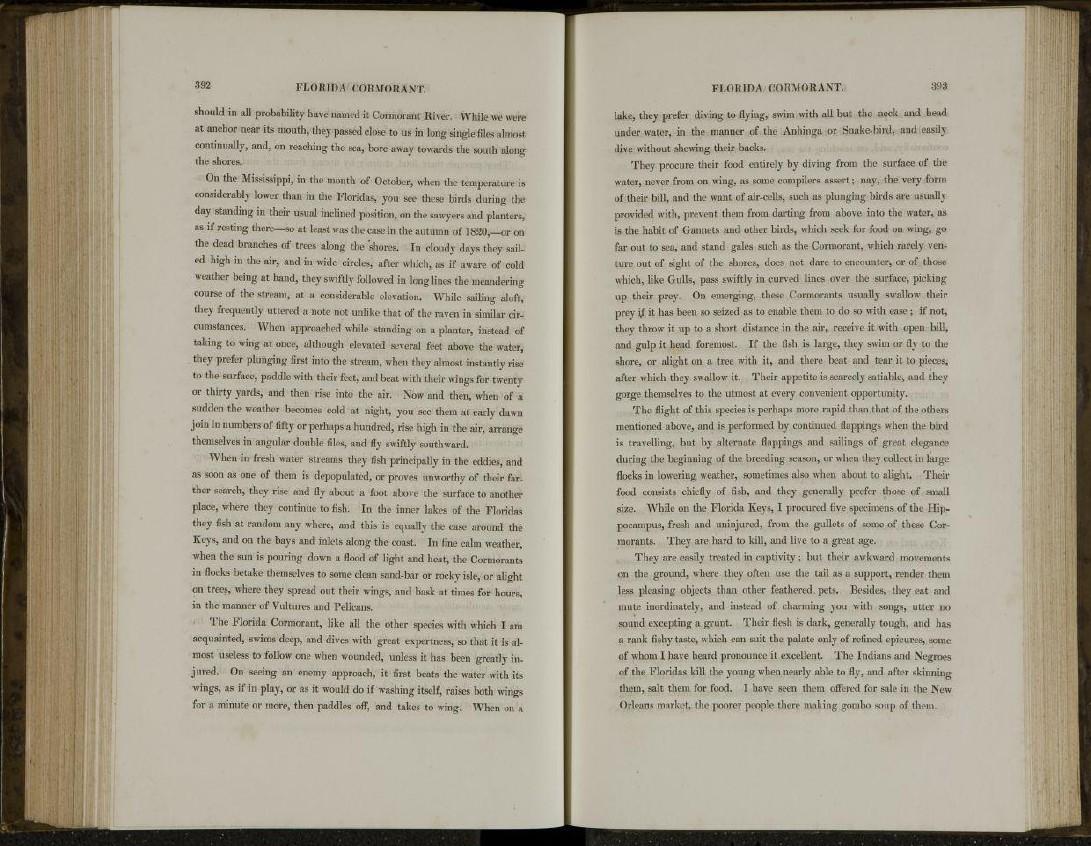
should in all probability have named it Cormorant River. While we were
at anchor near its mouth, they passed close to us in long single files almost
continually, and, on reaching the sea, bore away towards the south along
the shores.
On the Mississippi, in the month of October, when the temperature is
considerably lower than in the Floridas, you see these birds during the
day standing in their usual inclined position, on the sawyers and planters,
as if resting there—so at least was the case in the autumn of 1820,—or on
the dead branches of trees along the shores. In cloudy days they sailed
high in the air, and in wide circles, after which, as if aware of cold
weather being at hand, they swiftly followed in long lines the meandering
course of the stream, at a considerable elevation. While sailing aloft,
they frequently uttered a note not unlike that of the raven in similar circumstances.
When approached while standing on a planter, instead of
taking to wing at once, although elevated several feet above the water,
they prefer plunging first into the stream, when they almost instantly rise
to the surface, paddle with their feet, and beat with their wings for twenty
or thirty yards, and then rise into the air. Now and then, when of a
sudden the weather becomes cold at night, you see them at early dawn
join in numbers of fifty or perhaps a hundred, rise high in the air, arrange
themselves in angular double files, and fly swiftly southward.
When in fresh water streams they fish principally in the eddies, and
as soon as one of them is depopulated, or proves unworthy of their farther
search, they rise and fly about a foot above the surface to another
place, where they continue to fish. In the inner lakes of the Floridas
they fish at random any where, and this is equally the case around the
Keys, and on the bays and inlets along the coast. In fine calm weather,
when the sun is pouring down a flood of light and heat, the Cormorants
in flocks betake themselves to some clean sand-bar or rocky isle, or alight
on trees, where they spread out their wings, and bask at times for hours,
in the manner of Vultures and Pelicans.
The Florida Cormorant, like all the other species with which I am
acquainted, swims deep, and dives with great expertness, so that it is almost
useless to follow one when wounded, unless it has been greatly injured.
On seeing an enemy approach, it first beats the water with its
wings, as if in play, or as it would do if washing itself, raises both wings
for a minute or more, then paddles off, and takes to wing. When on a
lake, they prefer diving to flying, swim with all but the neck and head
under water, in the manner of the Anhinga or Snake-bird, and easily
dive without shewing their backs.
They procure their food entirely by diving from the surface of the
water, never from on wing, as some compilers assert; nay, the very form
of their bill, and the want of air-cells, such as plunging birds are usually
provided with, prevent them from darting from above into the water, as
is the habit of Gannets and other birds, which seek for food on wing, go
far out to sea, and stand gales such as the Cormorant, which rarely venture
out of sight of the shores, does not dare to encounter, or of those
which, like Gulls, pass swiftly in curved lines over the surface, picking
up their prey. On emerging, these Cormorants usually swallow their
prey if it has been so seized as to enable them to do so with ease ; if not,
they throw it up to a short distance in the air, receive it with open bill,
and gulp it head foremost. If the fish is large, they swim or fly to the
shore, or alight on a tree with it, and there beat and tear it to pieces,
after which they swallow it. Their appetite is scarcely satiable, and they
gorge themselves to the utmost at every convenient opportunity.
The flight of this species is perhaps more rapid than that of the others
mentioned above, and is performed by continued flappings when the bird
is travelling, but by alternate flappings and sailings of great elegance
during the beginning of the breeding season, or when they collect in large
flocks in lowering weather, sometimes also when about to alight. Their
food consists chiefly of fish, and they generally prefer those of small
size. While on the Florida Keys, I procured five specimens of the Hippocampus,
fresh and uninjured, from the gullets of some of these Cormorants.
They are hard to kill, and live to a great age.
They are easily treated in captivity; but their awkward movements
on the ground, where they often use the tail as a support, render them
less pleasing objects than other feathered pets. Besides, they eat and
mute inordinately, and instead of charming you with songs, utter no
sound excepting a grunt. Their flesh is dark, generally tough, and has
a rank fishy taste, which can suit the palate only of refined epicures, some
of whom I have heard pronounce it excellent. The Indians and Negroes
of the Floridas kill the young when nearly able to fly, and after skinning
them, salt them for food. I have seen them offered for sale in the New
Orleans market, the poorer people there making gombo soup of them.